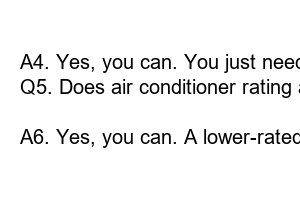에어컨 평수 계산
As summer approaches, air conditioning becomes a necessity for maintaining comfort in our homes and offices. However, with numerous options available in the market, choosing the right one can be overwhelming. One way to make an informed decision is by understanding the air conditioner rating calculation. In this post, we will break down the basics of air conditioner rating calculation to help you make the best choice for your needs.
What is Air Conditioner Rating Calculation?
Air conditioner rating calculation is a measure of the system’s cooling and heating efficiency. It is expressed in British Thermal Units (BTUs). The higher the BTU rating, the more powerful the air conditioner will be in cooling the room. However, higher ratings also translate to more energy consumption and higher costs.
How is Air Conditioner Rating Calculated?
Air conditioner rating is calculated based on the unit’s Energy Efficiency Ratio (EER) or Seasonal Energy Efficiency Ratio (SEER). EER measures the cooling power of the air conditioner per unit of energy consumed, while SEER measures the same thing but over an entire season. The formula to calculate EER is as follows: BTU/h ÷ Watts = EER. SEER is calculated by dividing the total cooling output per season by the total energy used during that season.
Factors that Affect Air Conditioner Rating Calculation
Several factors affect air conditioner rating calculation, including the size of the room, the number of occupants, the level of insulation, and the climate. For example, an air conditioner with a higher rating would be more effective in a large room with high occupancy levels, less insulation, and a hot climate.
Types of Air Conditioner Ratings
There are two types of air conditioner ratings based on their mode of operation – cooling and heating. The cooling rating is expressed in terms of BTU/h, while the heating rating is expressed in terms of Heating Seasonal Performance Factor (HSPF). HSPF measures the heating effectiveness of the air conditioner by dividing the total heating output per season by the total energy used during that period.
Why is Air Conditioner Rating Calculation Important?
Air conditioner rating calculation is essential when choosing the right model for your needs. A unit with an EER rating of 10 is twice as efficient as one with a rating of 5. Therefore, a higher-rated air conditioner will save energy and reduce your bills. It is also important to note that higher-rated air conditioners have a lower impact on the environment, making them a more sustainable choice.
Conclusion
Air conditioner rating calculation is an essential aspect of choosing the right unit for your needs. Whether you are looking for a cooling or heating air conditioner, understanding the rating calculation will help you make an informed decision. Factors like room size, level of insulation, and occupancy levels will also affect the rating calculation. Higher-rated units offer better efficiency, energy savings, and environmental sustainability.
FAQs
Q1. What is the ideal air conditioner rating for a small room?
A1. For a small room, an air conditioner with a rating of 6,000 to 8,000 BTUs is ideal.
Q2. Does higher air conditioner rating mean faster cooling?
A2. Not necessarily. The air conditioner’s cooling speed also depends on factors like room size, insulation, and occupancy levels.
Q3. What is the difference between EER and SEER?
A3. EER measures instantaneous cooling power, while SEER measures the same thing over an entire season.
Q4. Can I calculate the air conditioner rating calculation myself?
A4. Yes, you can. You just need to know the BTUs and Watts of the unit and use the formula to calculate EER.
Q5. Does air conditioner rating affect noise level?
A5. Not necessarily. The air conditioner’s noise level depends on factors like the type of compressor and the speed settings.
Q6. Can I save energy by choosing a lower-rated air conditioner?
A6. Yes, you can. A lower-rated air conditioner will use less energy, but it may not be as effective in cooling or heating the room. It’s important to balance energy savings with efficiency.

